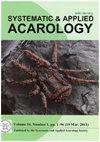汉fodii Ahy1株对巴氏新小绥螨对荨麻疹叶螨功能反应的影响
IF 1.2
3区 农林科学
Q2 ENTOMOLOGY
引用次数: 0
摘要
摘要荨麻疹叶螨(Tetranychus teticae)是世界上危害农田和温室作物经济的主要螨害之一。为了明确巴氏新小绥螨在昆虫病原真菌(Acremonium hansfodii)存在的情况下对荨麻疹叶螨的防治效果。本试验旨在评价巴氏奈瑟氏体与汉斯福奈瑟氏体联用对荨麻疹的防治效果。结果表明,Ahy1菌株处理巴氏奈瑟菌对荨麻疹的功能响应符合Holling II型方程。其中,捕食卵的捕食次数最多,攻击时间最短,其次是捕食若虫,雌成虫最少。Ahy1菌株处理的巴氏奈瑟菌对荨麻疹奈瑟菌的反应也符合Holling II型方程。barkern .对经Ahy1菌株处理的荨荨蛾若虫和雌成虫的捕食能力随着Ahy1菌株浓度的增加而增加,但对取食卵的捕食能力无显著差异。因此,EPF与barkeri联合防治TSSM具有协同效应,将为开展虫生真菌与掠食性螨的联合利用提供指导。本文章由计算机程序翻译,如有差异,请以英文原文为准。
The influence of Ahy1 strain of Acremonium hansfodii on functional response of Neoseiulus barkeri to Tetranychus urticae
Abstract The two spotted spider mite (TSSM) Tetranychus urticae is one of the most economically key mite pests of fields and greenhouse crops over the world. In order to clarify the control efficacy of Neoseiulus barkeri on Tetranychus urticae in the presence of entomopathogenic fungus (EPF) Acremonium hansfodii. This study was conducted to evaluate the control of combining N. barkeri with A. hansfodii against T. urticae. The results showed that the functional response of N. barkeri treated with Ahy1 strain to T. urticae was Holling type II equation. Among these, the highest predation number and the shortest attack time were obtained for the predator feeding on eggs, then followed by feeding on nymphs, female adults ranked as the lowest. That of N. barkeri to T. urticae treated with Ahy1 strain was also Holling type II equation. The predation capacity of N. barkeri on nymphs and female adults of T. urticae treated by Ahy1 strain increased with the increase of the concentration of Ahy1 strain, but that when feeding eggs had no significant difference. Therefore, the combination of EPF with N. barkeri on control of TSSM had synergistic effects, which will provide the guidance to carry out combined utilization of entomogenous fungi with predatory mites.
求助全文
通过发布文献求助,成功后即可免费获取论文全文。
去求助
来源期刊

Systematic and Applied Acarology
ENTOMOLOGY-
CiteScore
2.20
自引率
33.30%
发文量
152
期刊介绍:
Systematic and Applied Acarology (SAA) is an international journal of the Systematic and Applied Acarology Society (SAAS). The journal is intended as a publication outlet for all acarologists in the world.
There is no page charge for publishing in SAA. If the authors have funds to publish, they can pay US$20 per page to enable their papers published for open access.
SAA publishes papers reporting results of original research on any aspects of mites and ticks. Due to the recent increase in submissions, SAA editors will be more selective in manuscript evaluation: (1) encouraging more high quality non-taxonomic papers to address the balance between taxonomic and non-taxonomic papers, and (2) discouraging single species description (see new special issues for single new species description) while giving priority to high quality systematic papers on comparative treatments and revisions of multiple taxa. In addition to review papers and research articles (over 4 printed pages), we welcome short correspondence (up to 4 printed pages) for condensed version of short papers, comments on other papers, data papers (with one table or figure) and short reviews or opinion pieces. The correspondence format will save space by omitting the abstract, key words, and major headings such as Introduction.
 求助内容:
求助内容: 应助结果提醒方式:
应助结果提醒方式:


